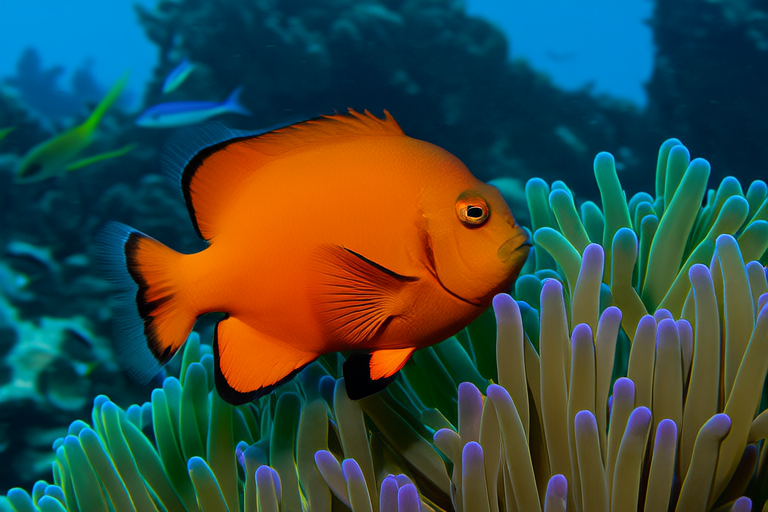Clownfish: Unique Behaviors, Care Requirements, and Lesser-Known Facts
Clownfish, or anemonefish, are some of the most popular aquarium fish due to their vibrant colors and intriguing behaviors. As a keeper, understanding their unique behaviors, care requirements, and lesser-known facts is essential for providing them with a healthy and stimulating environment. This article delves into their social structures, dietary needs, environmental preferences, and interactions with sea anemones. Additionally, it addresses common misconceptions and provides expert tips for optimal clownfish care.
Social Structures
Clownfish live in small groups within a single sea anemone, typically consisting of a breeding pair and up to four non-breeding, immature females. The dominant female is the largest in the group, while the male is the second-largest. If the dominant female dies, the largest male will change sex and become the new dominant female. This remarkable ability to change gender is known as sequential hermaphroditism.
In captivity, clownfish can be kept in pairs or small groups. However, it is crucial to introduce all fish simultaneously to avoid aggressive behavior. When introducing new clownfish, keepers should observe their interactions closely to ensure compatibility. Clownfish are generally peaceful towards other species, but they may display territorial behavior if space is limited.
Dietary Needs
Clownfish are omnivorous, feeding on a variety of foods including algae, zooplankton, and small invertebrates. In the wild, they primarily consume copepods, amphipods, and other tiny crustaceans. In captivity, they can thrive on a diet of high-quality flake food, pellets, and occasional frozen or live foods such as brine shrimp, mysis shrimp, and bloodworms. It is important to offer a balanced diet to ensure proper nutrition and prevent health issues.
Feeding clownfish twice daily is recommended, but care should be taken not to overfeed them. Overfeeding can lead to obesity and water quality issues. A good rule of thumb is to feed them only what they can consume within two minutes. Additionally, providing a varied diet helps maintain their vibrant colors and overall health.
Environmental Preferences
Clownfish prefer warm, tropical waters with temperatures ranging from 74°F to 82°F (23°C to 28°C). They require a stable pH level between 8.1 and 8.4, with a specific gravity of 1.020 to 1.025. Maintaining these conditions is crucial for their well-being. Regular monitoring of water parameters is essential to ensure a healthy environment.
Clownfish also benefit from a spacious tank with plenty of hiding spots and swimming areas. A minimum tank size of 20 gallons is recommended for a single pair, with additional space required for larger groups. Decorations such as rocks, caves, and PVC pipes provide shelter and encourage natural behaviors. A robust filtration system is necessary to maintain water quality and remove waste products.
Interactions with Sea Anemones
One of the most fascinating aspects of clownfish biology is their symbiotic relationship with sea anemones. The anemone provides protection from predators, while the clownfish brings food and removes waste. The clownfish’s mucus layer protects it from the anemone’s stinging cells, allowing it to move freely among the tentacles.
In captivity, clownfish can live without an anemone, but many hobbyists choose to provide one for aesthetic and behavioral reasons. Some popular anemone species for clownfish include Heteractis magnifica, Stichodactyla gigantea, and Entacmaea quadricolor. When selecting an anemone, consider its size, compatibility with the clownfish, and care requirements. Proper acclimation and gradual introduction are crucial to ensure both the clownfish and anemone adapt successfully.
Common Misconceptions
One common misconception about clownfish is that they always need an anemone to survive. While this is true in the wild, captive clownfish can thrive without one. Another misconception is that all clownfish are suitable for beginner aquarists. While some species, such as the ocellaris clownfish (Amphiprion ocellaris), are relatively hardy, others require more advanced care. It is essential to research each species’ specific needs before adding them to an aquarium.
Additionally, many believe that clownfish are immune to the venom of sea anemones. While they are protected by their mucus layer, this protection can be compromised by stress, poor water quality, or handling. Therefore, maintaining a healthy environment is crucial for preventing injury.
Expert Tips for Optimal Clownfish Care
To ensure the best possible care for your clownfish, follow these expert tips:
- Provide a spacious, well-decorated tank with ample hiding spots and swimming areas.
- Maintain stable water parameters through regular testing and adjustments.
- Feed a varied diet to promote vibrant colors and overall health.
- Introduce new fish simultaneously to prevent aggression.
- Monitor for signs of stress or illness, and take prompt action if necessary.
- Consider adding an anemone for aesthetic and behavioral benefits, but ensure compatibility and proper acclimation.
Fascinating Observations
Those who closely observe clownfish often notice several intriguing behaviors. For example, clownfish have been observed engaging in elaborate courtship rituals, including chasing, nudging, and fin displays. These behaviors are particularly noticeable during spawning periods when the breeding pair prepares to mate.
Another fascinating observation is the way clownfish interact with their anemone hosts. They frequently clean the anemone by removing debris and parasites, which helps maintain the anemone’s health. Additionally, clownfish have been observed “dancing” around their anemone, possibly to stimulate the tentacles and increase circulation.
Closely watching clownfish can also reveal subtle changes in their behavior that indicate stress or illness. For instance, a normally active fish that suddenly becomes lethargic or hides excessively may be experiencing health issues. Early detection and intervention are key to ensuring a quick recovery.
